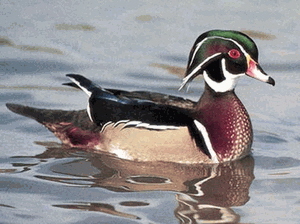
Wood Ducks are found in eastern North America from southern Canada to the southern coast of the United States. They are also found along parts of North America's West Coast. Woodland streams or pools, forest bottomlands, river valleys, swamps, marshes, lakes, and creeks are all typical Wood Duck habitat. Female Wood Ducks exhibit extreme site fidelity, returning to the same breeding ground year after year while Wood Ducks residing in southern North America tend to be year-round residents.
The breeding season begins in April in the southern portion of the range. In northern areas, Wood Ducks arrive on the breeding ground soon after the ice thaws, usually in early May. There are, however, reports of Wood Ducks in Canada beginning to nest as early as the second week of April. The nests are not necessarily at the water's edge. Many Wood Ducks nest up to a half-mile away from the water: a distance still close enough that the female can lead her young to water after they leave the nest.
Wood Duck houses should be mounted on a post or deciduous tree 6 to 8 feet high with the entrance hole facing south or west and within 30 to 100 feet from the nearest water. In situations where nest boxes are in close proximity to one another, female Wood Ducks seem to have difficulty discerning which nest box is theirs. Consequently, more than one female lays eggs in a single box, creating very large clutches that cannot be effectively incubated; these clutches subsequently fail. As a rule, it is best not to put up Wood Duck houses within sight of each other.